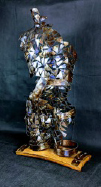United Colors Nordic-Spain by Artishow

Fechas / Desde
28/11 – 20/12 2024
Inauguración:
28/11 – 20/12 2024
Desde: 19:00 con invitación a partir de las 20:00 abierto a todo el público.
Salón de exposiciones:
Picasso
Todos los viernes de 17:00-19:00 personal a su disposición en el salón de exposiciones.
Resto de los días reserve su “vernissage privado” enviando un SMS
al +46 70 245 14 45

Dates / From
28/11 – 20/12 2024
Opening:
28/11 – 20/12 2024
From: 19:00 with invitation from 20:00 open to the public.
Exhibition Hall:
Picasso
Every Friday from 17:00-19:00 staff at your disposal in the exhibition hall.
Rest of the days, book a “private vernissage” by sending an SMS
to: +46 70 245 14 45

Angelica Wiik







Antonio Soler









Carlos Menéndez







Fernando Sáenz de Elorrieta


Carlos Menéndez (1962, Madrid). An unrepentant traveler, who at 18 set off to explore South America. In 1998, he decided to end the initiatory journey of his life and settled in Madrid until 2006, when he moved to Murcia, where he began the fascinating artistic and plastic journey. Although art had always been very present in his life, he had never considered it from a professional standpoint, and much less as a full-time occupation.
All of this life experience—getting to know and share with other cultures, the memories, and moments brought by “travel”—is reflected definitively in his work. He had always had a strong artistic drive, which was nurtured by these circumstances that awakened a deep curiosity for the History of Art and, more specifically, a great interest in the execution of artistic production.
His artistic profile can be defined as that of a multidisciplinary artist, interested in social and pictorial art, close to realistic figuration in the world of painting, where he especially works on psychological portraiture, combining it with traditional oil painting techniques. He is currently working on his personal project involving the creation and management of artistic work, which he combines with his work in the art and creation group Trazo







IdeasDpapel


Drawing has been our main form of expression since our time at the School of Architecture.
After approaching our works with different techniques, for several years now we have focused on the COLLAGE technique, our favorite, which allows us great expressiveness.
We mainly use newspapers and magazines where we find all kinds of colors, textures, images, and reviews that help make each work impactful, unique, and unrepeatable.
Our training as architects has led us to favor the urban landscape, but we also create portraits personalized with scenes related to the person being portrayed, achieving great warmth and expressiveness.
It is also worth noting that our works evolve depending on the type of paper we use at any given moment, intentionally taking advantage of the tonal changes that occur in it over time.
These are, therefore, “living” works.
Our motto: “Come closer to see, move away to understand.”







Juan Francisco Gómez Cambronero









Martina Ehrenborg










Miguel Ramón Monegal









Pilar Correa









Stefan Wentzel










Tomas Lacke















Toni Coll







